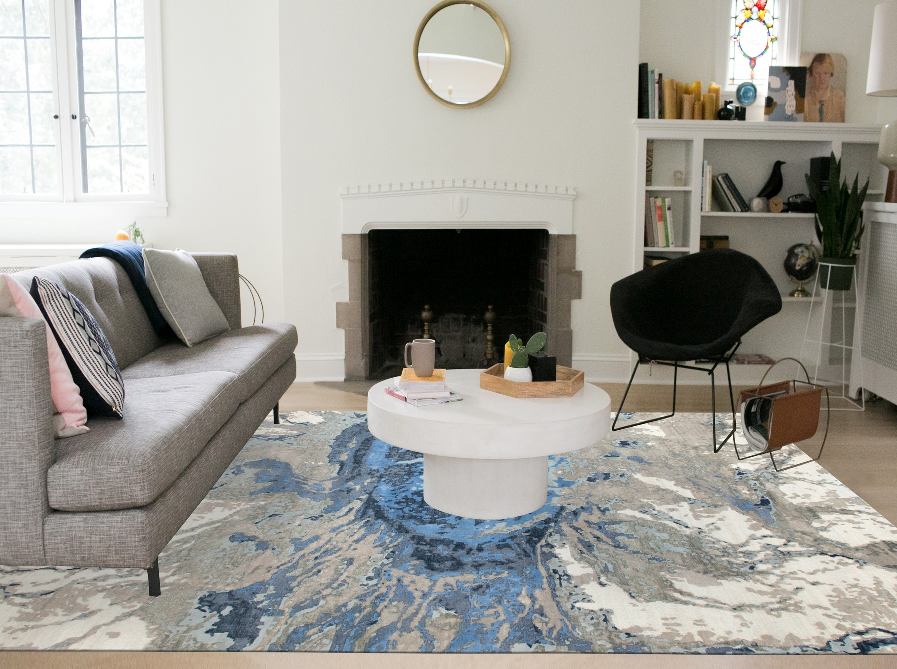Remember when “milk” meant one thing and one thing only? In the last few decades there’s been a surge of plant-based “milk” or “mylk” liquids that directly compete with cow’s milk in supermarkets. In the
Remember when “milk” meant one thing and one thing only? In the last few decades there’s been a surge of plant-based “milk” or “mylk” liquids that directly compete with cow’s milk in supermarkets. In the rug world there’s a similar situation with silk. Not long ago silkworm fiber was the only fiber that was described as “silk”, but increasingly the word “silk” also describes lustrous, silky fibers made from plants. The most common of these fibers is “bamboo silk”. To avoid confusion with silkworm fibers, plant-based silky fibers are often called “art silk”, sometimes “artificial silk”, and also “viscose”.

S&H rugs are always handmade and always woven from natural fibers. We use both silkworm silk and bamboo silk. Many of our rugs weave together the best of two worlds – the strength and warmth of wool highlighted with the luster and light refracting qualities of silk whether that’s silk from silkworms or bamboo. Does it matter which “silk” you choose for your rug? Your choice should consider several factors. Bamboo silk is a less expensive option than silkworm silk. Another factor to consider is how easy it is to care for and clean your rug. Wool is renowned for its durability, relative resistance to stains, and ease of cleaning, but the same isn’t true for silkworm or art silk. As more and more consumers opt for the shine, luster and affordability of art silk, we offer a few hints on how to care for rugs woven from plant-based “silk” fibers.
Yellowing is the downside of art silk or at least it’s a downside if you don’t know how to care for your rug. If you know a few preventative measures then yellowing won’t be a problem, or if it does happen you’ll know how to fix the problem. It helps to know why yellowing can occur. Art silk is a cellulose plant-based fiber. Cellulose is a very absorbent fiber with a natural tendency to yellow when it comes in contact with water. Despite this supposedly “negative” feature, art silk is widely used by high-end, luxury rug manufacturers. So here’s the question to ask yourself: would luxury companies use a fiber that couldn’t be color-corrected when stained? The answer is no. Here’s why.

The first rule of thumb is never use water to treat a spill or stain on an art silk rug. Never! The first thing to do is blot the stain with an absorbent, undyed cloth or use a white paper towel. Press down on the stain and lift (don’t rub!). Move the cloth to a clean area and press and blot again. Do this as many times as necessary until the cloth no longer absorbs the stain and looks “clean”.
But what if the stain was caused by water or the stain doesn’t lift after blotting or the stain is old? Then it’s time to use a citric “acid” (meaning a natural, organic acid, not a caustic chemical) to reverse yellowing if water came in contact with the rug or to remove a stain. We suggest you call a professional cleaning company, but we’ll give you a few tips so you’ll know what to ask before deciding who should clean your rug.
“Browning” on natural fiber rugs (especially jute and sisal) and upholstered furniture has been known for decades long before the introduction of art silk. The cause of browning is usually high-pH detergents that leave a surface residue that eventually “browns” or “yellows”. The corrective is an acid agent which professionals usually call a “browning agent” because the word “acid” has negative connotations. This tried-and-true method is now also used for art silk rugs. A professional will neutralize the stain with a topical application of a formulated organic acid browning agent that is safe for people and pets. This will remove the browning or yellowing.
Art silk rugs have a delicate beauty and high, reflective sheen. They look and feel luxurious. The fibers have natural tonal variations that add delightful visual interest because the surface of the rug will “magically” shift from highlights to lowlights due to changing light levels in a room or due to the angle from which the rug is viewed (in other words colors may seem to shift when you’re standing as opposed to sitting in a chair).
The bottom line is don’t be dissuaded from choosing a lustrous art silk because of the possibility of stains. Just keep in mind that light colored rugs of any type of fiber are more likely to show stains than dark colored rugs. For high-traffic areas or homes with animals and children, you might consider patterned, rather than plain, art silk rugs. And finally, don’t panic if a stain occurs. Life happens!
